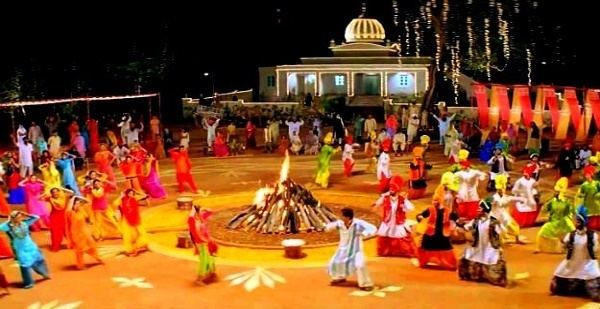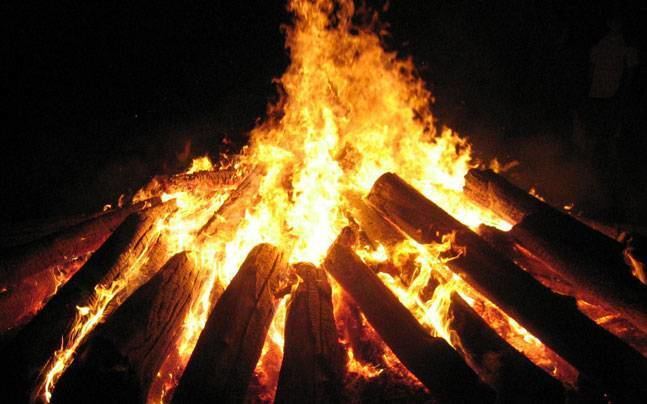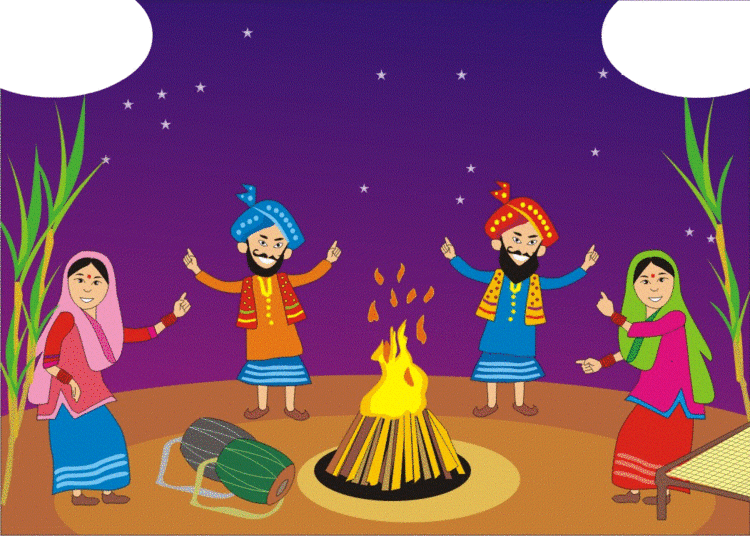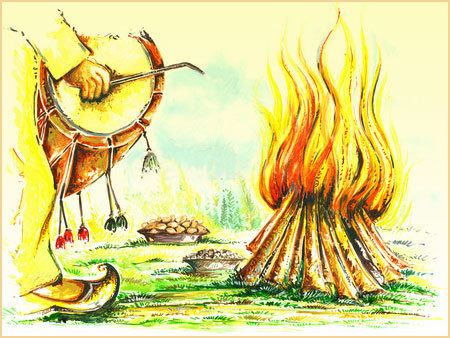Observed by Sikhs, Hindus, others Observances Bonfire, song and dance Featured in religions Hinduism | 2017 Date 13 January 2017 Type of holiday Traditional, Seasonal | |
 | ||
Significance Midwinter festival, celebration of Winter Solstice Celebrations Bonfire, song and dance (Bhangra and Gidda ) | ||
Lohri india s bonfire festival
Lohri (Gurmukhi: ਲੋਹੜੀ, Devanagari: लोहड़ी, Shahmukhi: لوہڑی) is a popular winter time Punjabi folk festival, celebrated primarily by Sikhs and Hindus from the Punjab region of Indian subcontinent. The significance and legends about the Lohri festival are many and these link the festival to the Punjab region. Many people believe the festival commemorates the passing of the winter solstice. Lohri marks the end of winter season, and is a traditional welcome of longer days and sun's journey to the northern hemisphere by Sikhs and Hindus in the northern regions of the Indian subcontinent. It is observed the night before Makar Sankranti, also known as Maghi, and according solar part of the lunisolar Bikrami calendar and typically falls about the same date every year (January 13).
Contents
- Lohri india s bonfire festival
- Learn hindi holidays lohri punjabi harvest festival
- Date
- Origins
- Significance
- Celebrations Bonfire and festive foods
- Collecting Lohri items and trick or treating
- Practices
- Lohri and the financial year
- Where celebrated
- Celebrations
- Lohri songs
- Other legends of the origin of Lohri festival
- Other parts of India
- Similar festivals in other countries
- References

Lohri is an official gazetted holiday in the state of Punjab (India), but it is not a holiday in Punjab (Pakistan). It is, however, observed by some Punjabi Muslims and Christians in Pakistan as well.

Learn hindi holidays lohri punjabi harvest festival
Date

Lohri is linked to the Bikrami calendar, and is celebrated the day before the festival of Maghi celebrated in India as Makar Sankranti. Lohri falls in the month of Paush and is set by the solar part of the lunisolar Indian calendar, i.e. in most years it falls on 13 January of the Gregorian calendar (in exception years on 12 or 14 January). Makara (Maghi) sankranti (Sangrand) marks beginning of the solar maagha masa.

For the general latitude and longitude of Punjab, 13 January represents the day after which sunrise occurs progressively earlier in the morning, till about 10–12 June. After these days in June, sunrise begins to occur progressively later in the morning till about 10–12 January. Therefore, the celebration of lohri on 13 January every year signifies the shift to longer days.
Origins

There are many folklores about Lohri. Lohri is the celebration of the arrival of longer days after the winter solstice. According to folklore, in ancient times Lohri was celebrated at the end of the traditional month when winter solstice occurs. It celebrates the days getting longer as the sun proceeds on its northward journey. The day after Lohri is celebrated as Maghi Sangrand.

In its origins, Lohri is an ancient mid winter Hindu festival, in regions near the Himalayan mountains where winter is colder than the rest of the subcontinent. Hindus traditional lit bonfires in their yards after the weeks of the rabi season cropping work, socialized around the fire, sang and danced together as they marked the end of winter and the onset of longer days. After the night of bonfire celebrations, the Hindu would mark Makar Sankranti and go to a sacred water body such as a river or lake to bathe.
However, instead of celebrating Lohri on the eve of when winter solstice actually occurs, Punjabis celebrate it on the last day of the month during which winter solstice takes place. Lohri commemorates the passing of the winter solstice.
Significance
The ancient significance of the festival is both as a winter crop season celebration and a remembrance of the Sun deity (Surya). Lohri songs mention the Indian Sun god asking for heat and thanking him for his return. Another legend explains the celebration as a folk reverence for fire (Agni).
Yet another folklore links Lohri to the tale of Dulla Bhatti. The central theme of many Lohri songs is the legend of Dulla Bhatti, whose real name was Abdullah Bhatti and lived in Punjab during the reign of Mughal Emperor Akbar. He was regarded as a hero in Punjab, for rescuing Punjabi girls from being forcibly taken to be sold in slave market of the Middle East. Amongst the were two girls he saved were Sundri & Mundri, who gradually became theme of Punjab' folklore. As a part of Lohri celebrations, children go around homes singing the traditional folk songs of Lohri with "Dulla Bhatti" name included. One person sings, while others end each line with a loud "Ho!" sung in unison. After the song ends, the adult of the home is expected to give snacks and money to the singing troupe of youngsters.
Celebrations: Bonfire and festive foods
Lohri is celebrated with a bonfire. The lighting of bonfire during this winter festival is an ancient tradition.
Sugarcane products such as gurh and gachak are central to Lohri celebrations, as are nuts which are harvested in January. The other important food item of Lohri is radish which can be harvested between October and January. Mustard greens are cultivated mainly in the winter months because the crop is suitable to the agro-climatic conditions. Accordingly, mustard greens are also a winter produce. It is traditional to eat Gajak, Sarson da saag with Makki di roti, radish, ground nuts and jaggery. It is also traditional to eat "til rice" which is made by mixing jaggery, sesame seeds and rice. In some places, this dish is called 'Tricholi.'
Collecting Lohri items and trick or treating
In various places of the Punjab, about 10 to 15 days before Lohri, groups of young and teenage boys and girls go around the neighbourhood collecting logs for the Lohri bonfire. In some places, they also collect items such as grains and jaggery which are sold and the sale proceeds are divided amongst the group.
A popular activity engaged in by boys is to select a group member to smear his face with ash and tie a rope around his waist! The idea is for the selected person to act as a deterrent for people who refrain from giving Lohri items. The boys will sing Lohri songs asking for Lohri items. If not enough is given, the householder will be given an ultimatum to either give more or the rope will be loosened. If not enough is given, then the boy who has his face smeared will try to enter the house and smash clay pots or the clay stove!
Practices
During the day, children go from door to door singing folk songs. These children are given sweets and savories, and occasionally, money. Turning them back empty-handed is regarded inauspicious. Where families are welcoming newly-weds and new borns, the requests for treats increases.
The collections gathered by the children are known as Lohri and consist of til, gachchak, crystal sugar, gur (jaggery), moongphali (peanuts) and phuliya or popcorn. Lohri is then distributed at night during the festival. Till, peanuts, popcorn and other food items are also thrown into the fire. For some, throwing food into the fire represents the burning of the old year and start the next year on Maghi
The bonfire ceremony differs depending on the location in Punjab. In some parts, a small image of the folk Lohri goddess is made with gobar (cattle dung) decorating it, kindling a fire beneath it and chanting its praises. The folk Lohri goddess is believed to be an ancient aspect of the celebration, and is part of a long tradition of Winter solstice celebrations manifesting as a god or goddess. In other parts, the Lohri fire consists of cow dung and wood with no reference to the Lohri goddess.
The bonfire is lit at sunset in the main village square. People toss sesame seeds, gur, sugar-candy and rewaries on the bonfire, sit around it, sing and dance till the fire dies out. Some people perform a prayer and go around the fire. This is to show respect to the natural element of fire, a tradition common in winter solstice celebrations. It is traditional to offer guests til, gachchak, gur, moongphali (peanuts) and phuliya or popcorn. Milk and water is also poured around the bonfire by Hindus to thank the Sun God and seeking his continued protection.
Among some sections of the Sindhi community, the festival is traditionally celebrated as Lal Loi. On the day of Lal Loee children bring wood sticks from their grand parents and aunties and light a fire burning the sticks in the night with people enjoying, dancing and playing around the fire. The festival is gaining popularity amongst other Sindhis where Lohri is not a traditional festival.
Lohri and the financial year
Historically, during the 19th century, revenue for winter crops was collected either on Lohri or Maghi.
Where celebrated
Lohri is celebrated to denote the last of the coldest days of winter. Apart from Punjab, people from other northern Indian states of the Punjab region (Haryana, Delhi, Himachal Pradesh), Chandigarh and Jammu) become busy making preparations for the festival. Lohri has been celebrated in Jammu since Mughal times. The festival is observed as Lal Loi in the Sindhi community.
Celebrations
In houses that have recently had a marriage or childbirth, Lohri celebrations will reach a higher pitch of excitement. Punjabis usually have private Lohri celebrations, in their houses. Lohri rituals are performed, with the accompaniment of special Lohri songs.
Singing and dancing form an intrinsic part of the celebrations. People wear their brightest clothes and come to dance the bhangra and gidda to the beat of the dhol. Punjabi songs are sung, and everybody rejoices. Sarson da saag and makki di roti is usually served as the main course at a Lohri dinner. Lohri is a great occasion that holds great importance for farmers. However, people residing in urban areas also celebrate Lohri, as this festival provides the opportunity to interact with family and friends.
Lohri songs
There are many Lohri songs. For example, the following song which has words to express gratitude to Dulla Bhatti (the 'ho's are in chorus):
Sunder mundriye ho!
Tera kaun vicharaa ho!
Dullah Bhatti walla ho!
Dullhe di dhee vyayae ho!
Ser shakkar payee ho!
Kudi da laal pathaka ho!
Kudi da saalu paata ho!
Salu kaun samete!
Chacha gali dese!
Chache choori kutti! zamidara lutti!
Zamindaar sudhaye!
Bum Bum bhole aaye!
Ek bhola reh gaya!
Sipahee far ke lai gaya!
Sipahee ne mari itt!
Bhaanvey ro te bhaanvey pitt!
Sanoo de de Lohri, te teri jeeve jodi!
(Laugh,cry or howl!)
Translation
Beautiful girl
Who will think about you
Dulla of the Bhatti clan will
Dulla's daughter got married
He gave one ser of sugar!
The girl is wearing a red suit!
But her shawl is torn!
Who will stitch her shawl?!
The uncle made choori!
The landlords looted it!
Landlords are beaten up!
Lots of simple-headed boys came!
One simpleton got left behind!
The soldier arrested him!
The soldier hit him with a brick!
(Cry or howl)!
Give us Lohri, long live your pair (to a married couple)!
Whether you cry, or bang your head later!
Other legends of the origin of Lohri festival
Some people believe that Lohri has derived its name from Loi, the wife of Saint Kabir. There is a legend amongst some people that Lohri comes from the word 'loh', which means the light and the warmness of fire. Lohri is also called lohi in rural Punjab. According to another legend Holika and Lohri were sisters. While the former perished in the Holi fire, the latter survived with Prahlad. Eating of til (sesame seeds) and rorhi is considered to be essential on Lohri day. Perhaps the words til and rorhi merged to become tilorhi, which eventually got shortened to Lohri.
Other parts of India
Lohri coincides with the festivals of Pongal, Bhogali Bihu and Bhogi.
In Andhra Pradesh, the day preceding Makara Sankranti is called Bhogi (భోగి) and this is when people discard old and derelict things and concentrate on new things causing change or transformation. At dawn people light a bonfire with logs of wood, other solid-fuels and wooden furniture at home that are no longer useful. The disposal of derelict things is where all old habits, vices, attachment to relations and material things are sacrificed in the sacrificial fire of the knowledge of Rudra, known as the "Rudra Gita Gyana Yagya". It represents realization, transformation and purification of the soul by imbibing and inculcating divine virtues.
Similar festivals in other countries
Winter solstice festivals have been incorporated into other festivals which are celebrated in various regions around the world. The festival of Yule is observed during Christmas celebrations whereby a log is burnt to commemorate the winter solstice.
The festival of Hogmanay is celebrated on new year’s day. The fire festival of Stonehaven in Scotland is the direct descendant of lighting winter solstice bonfires. Another event is observed every 11 January when the flaming Clavie (a barrel full of staves) is carried round in Burghead and is wedged on the Doorie Hill. When it is burnt out, people take the smouldering embers to bring good luck for the coming year.
